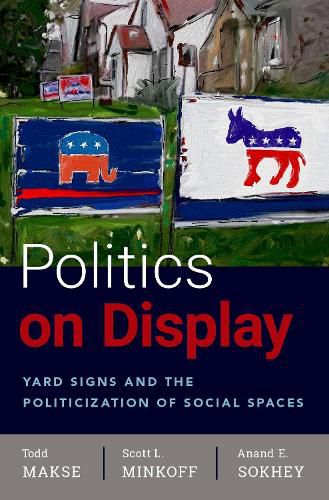Readings Newsletter
Become a Readings Member to make your shopping experience even easier.
Sign in or sign up for free!
You’re not far away from qualifying for FREE standard shipping within Australia
You’ve qualified for FREE standard shipping within Australia
The cart is loading…






Political yard signs are one of the most ubiquitous and conspicuous features of American political campaigns, yet they have received relatively little attention as a form of political communication or participation. In Politics on Display, Todd Makse, Scott L. Minkoff, and Anand E. Sokhey tackle this phenomenon to craft a larger argument about the politics of identity and space in contemporary America. Documenting political life in two suburban communities and a major metropolitan area, they use an unprecedented research design that leverages street-level observation of the placement of yard signs and neighborhood-specific survey research that delves into the attitudes, behavior, and social networks of residents. The authors then integrate these data into a geo-database that also includes demographic and election data. Supplemented by nationally-representative data sources, the book brings together insights from political communication, political psychology, and political geography. Against a backdrop of conflict and division, this book advances a new understanding of how citizens experience campaigns, why many still insist on airing their views in public, and what happens when social spaces become political spaces.
$9.00 standard shipping within Australia
FREE standard shipping within Australia for orders over $100.00
Express & International shipping calculated at checkout
Stock availability can be subject to change without notice. We recommend calling the shop or contacting our online team to check availability of low stock items. Please see our Shopping Online page for more details.
Political yard signs are one of the most ubiquitous and conspicuous features of American political campaigns, yet they have received relatively little attention as a form of political communication or participation. In Politics on Display, Todd Makse, Scott L. Minkoff, and Anand E. Sokhey tackle this phenomenon to craft a larger argument about the politics of identity and space in contemporary America. Documenting political life in two suburban communities and a major metropolitan area, they use an unprecedented research design that leverages street-level observation of the placement of yard signs and neighborhood-specific survey research that delves into the attitudes, behavior, and social networks of residents. The authors then integrate these data into a geo-database that also includes demographic and election data. Supplemented by nationally-representative data sources, the book brings together insights from political communication, political psychology, and political geography. Against a backdrop of conflict and division, this book advances a new understanding of how citizens experience campaigns, why many still insist on airing their views in public, and what happens when social spaces become political spaces.